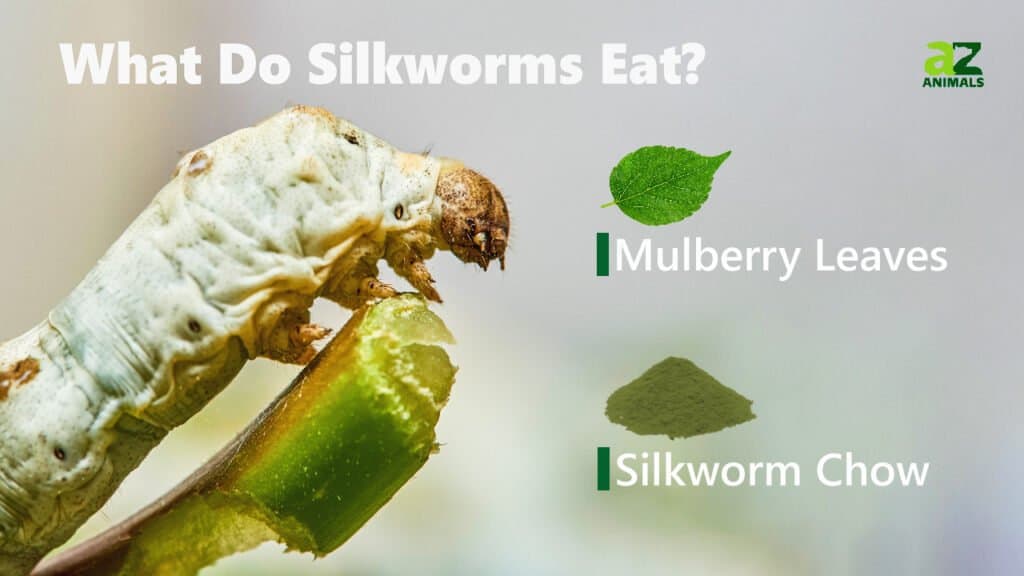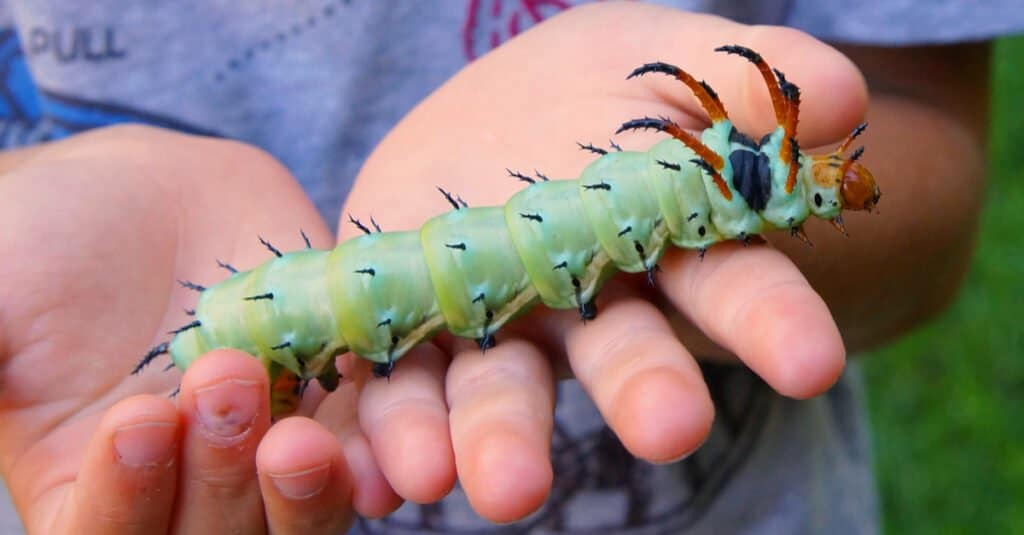Silkworms are insects of high economic importance because they are kept, reared, and nurtured to produce silk in large quantities. They produce smooth silk fabrics that are useful to humans in diverse ways. Since they are as useful as this, it becomes essential to ask the question, “what do silkworms eat?” because to produce silk optimally, they must have special foods that constitute their diet.
This article will discuss extensively the foods silkworms eat, how much silkworms eat yearly, and other important stuff.
What Do Silkworms Eat?

Silkworms mostly eat mulberry leaves.
©/Shutterstock.com
Silkworms eat vegetables mostly, especially mulberry leaves, and they are predominantly herbivores. The quality of food they eat determines the quality of silk they spin.
In feeding them, silkworms must be allowed to eat fresh and nutritious leaves most times to keep them hydrated. The quality of the food also determines how healthy and robust they will grow.
It is important to note that the best food for silkworms is mulberry leaves. They are the best bet for silkworms. However, in situations when you run out of mulberry leaves, other alternatives can be used in place of mulberry leaves. Though, it’s not advisable to keep feeding your silkworms with these alternatives for a long time.
Here’s a complete list of foods silkworms eat:
- Mulberry leaves
- Carrots
- Silkworm Chow
- Iceberg lettuce
- Violet leaves
- Beetroot leaves
Mulberry Leaves
Silkworms mostly eat mulberry leaves. Mulberry leaves, unlike other alternatives for silkworms, support proper growth and development. Naturally, the smell of mulberry leaves tends to attract silkworms. So, the main reason mulberry trees are planted and nurtured is to support the breeding of silkworms for commercial uses.
The soft mulberry leaves are best for young silkworms because they find it easier to chew them compared to the rough leaves. The adult silkworms can eat the coarse leaves, but it’s still good to feed them with soft leaves to keep them hydrated.
Carrots
Carrots aren’t the best for silkworms, but in situations when you run out of mulberry leaves to feed your silkworms, they could eat carrots as an alternative.
The carrot can be grated into bits before feeding your silkworms. This shouldn’t go on for a long time, and it should just be a matter of days because carrots might begin to affect the color of silkworms.
Silkworm Chow

Silkworms eat vegetables like mulberry leaves
©Deborah Lee Rossiter/Shutterstock.com
Silkworm chow is a direct derivative of mulberry leaves. It is a product of processed mulberry leaves and can also serve as an alternative for your silkworms when you are out of mulberry leaves. Chow can be purchased in local pet stores or online. It’s still better than other alternatives since it is made from mulberry leaves.
Iceberg Lettuce Leaves
When feeding a silkworm, it is crucial to dehydrate iceberg lettuce leaves before grinding them into fine form. When it’s time to feed your silkworms with them, you can rehydrate iceberg leaves to keep your silkworms hydrated. Silkworms should only eat iceberg lettuce leaves temporarily and not for a long time.
Violet Leaves
Violet leaves are also alternative food for your silkworms in emergencies. Like iceberg lettuce leaves, violet leaves should be dehydrated before grinding them into powder. Once again, these leaves will need to be rehydrated before feeding them to a silkworms. Violet leaves are a temporary solution (similar to iceberg lettuce or carrots) and aren’t a good long-term supplement for mulberry leaves.
Beetroot Leaves
Beetroot leaves in their fresh form can also be good alternatives for silkworms in times when mulberry leaves aren’t available for their consumption. It should also be noted that silkworms shouldn’t be fed beetroot leaves for more than two days. Silkworms eating beetroot leaves for more than two days could affect their color by making them reddish.
How Much Do Silkworms Eat Daily?

The quality of food silkworms eat determines the quality of silk produced
©Matt Jeppson/Shutterstock.com
An exciting thing about silkworms is that they have an excellent appetite. The exact quantity of food they eat per day is not an easy thing to establish because they grow at a fast rate.
Silkworms more or less grow larger as they eat every day. One good strategy for feeding silkworms is feeding them in bits rather than giving them all the leaves at once. The leaves will wilt, so it’s better to offer it to them in bits.
What Do Young Silkworms Eat?
Due to the fragile nature of young silkworms, they can’t eat hard mulberry leaves. Therefore, young mulberry leaves are the best for them, especially in the first week. The leaves should be about 0.5 to 1 inch in size for young silkworms to consume.
What Animals are Silkworms’ Predators?
Some animals like reptiles, amphibians, frogs, and snakes prey on silkworms. It is not harmful to offer silkworms as food to your pets, but they are not the best nutritional source since they only eat mulberry leaves and have only one source of nutrients. It won’t be very nutritious for your pets because they need different nutrient sources to remain healthy.
Silkworms are also prey to ants, mosquitoes, spiders, and other insects.
What Do Wild Silkworms Eat?
Due to the special diet of silkworms, they have become a rare sighting in the wild. So only domesticated silkworms can be observed on a larger scale. Mulberry trees don’t grow in every region in the wild, making it difficult for silkworms in areas where they can’t be found to survive. So it is safe to say silkworms can’t be found in large numbers in the wild due to limited mulberry trees.
The photo featured at the top of this post is © Deborah Lee Rossiter/Shutterstock.com
Thank you for reading! Have some feedback for us? Contact the AZ Animals editorial team.






